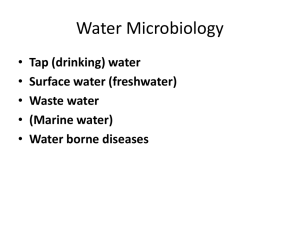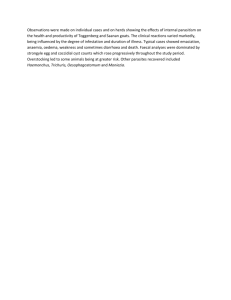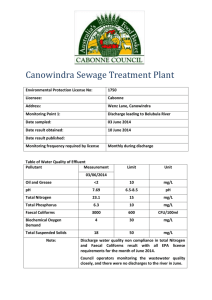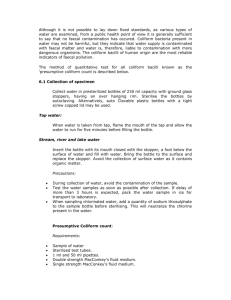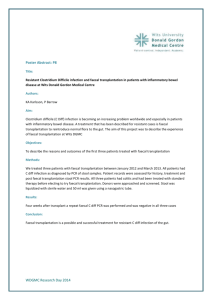Document 14111210
advertisement
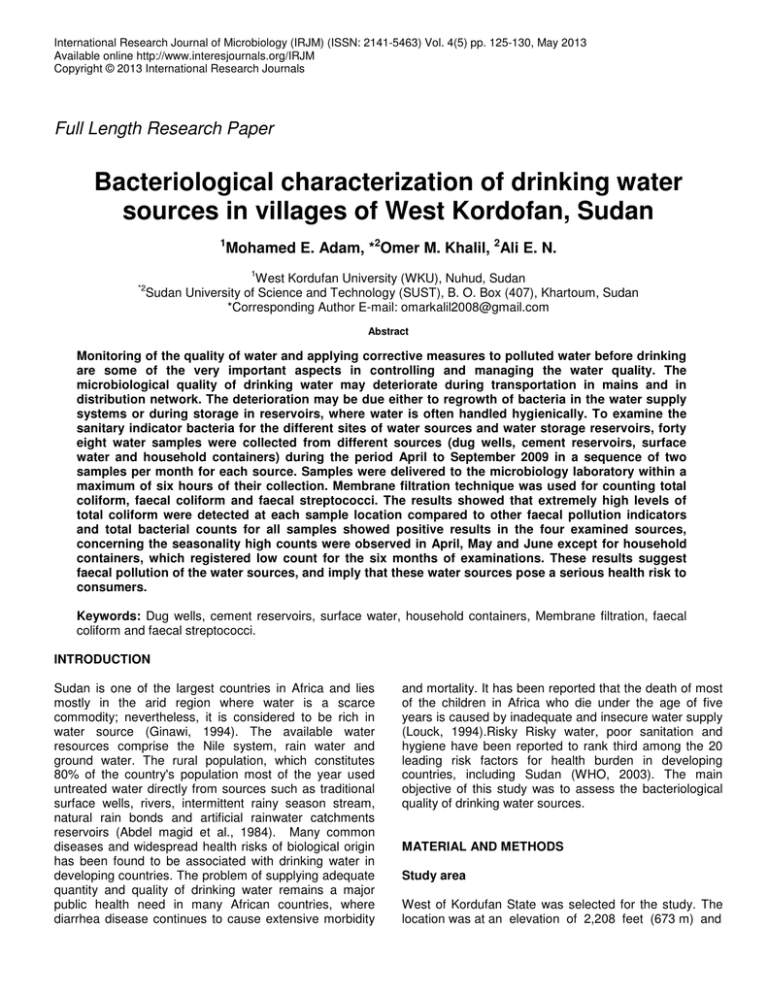
International Research Journal of Microbiology (IRJM) (ISSN: 2141-5463) Vol. 4(5) pp. 125-130, May 2013 Available online http://www.interesjournals.org/IRJM Copyright © 2013 International Research Journals Full Length Research Paper Bacteriological characterization of drinking water sources in villages of West Kordofan, Sudan 1 Mohamed E. Adam, *2Omer M. Khalil, 2Ali E. N. 1 West Kordufan University (WKU), Nuhud, Sudan Sudan University of Science and Technology (SUST), B. O. Box (407), Khartoum, Sudan *Corresponding Author E-mail: omarkalil2008@gmail.com *2 Abstract Monitoring of the quality of water and applying corrective measures to polluted water before drinking are some of the very important aspects in controlling and managing the water quality. The microbiological quality of drinking water may deteriorate during transportation in mains and in distribution network. The deterioration may be due either to regrowth of bacteria in the water supply systems or during storage in reservoirs, where water is often handled hygienically. To examine the sanitary indicator bacteria for the different sites of water sources and water storage reservoirs, forty eight water samples were collected from different sources (dug wells, cement reservoirs, surface water and household containers) during the period April to September 2009 in a sequence of two samples per month for each source. Samples were delivered to the microbiology laboratory within a maximum of six hours of their collection. Membrane filtration technique was used for counting total coliform, faecal coliform and faecal streptococci. The results showed that extremely high levels of total coliform were detected at each sample location compared to other faecal pollution indicators and total bacterial counts for all samples showed positive results in the four examined sources, concerning the seasonality high counts were observed in April, May and June except for household containers, which registered low count for the six months of examinations. These results suggest faecal pollution of the water sources, and imply that these water sources pose a serious health risk to consumers. Keywords: Dug wells, cement reservoirs, surface water, household containers, Membrane filtration, faecal coliform and faecal streptococci. INTRODUCTION Sudan is one of the largest countries in Africa and lies mostly in the arid region where water is a scarce commodity; nevertheless, it is considered to be rich in water source (Ginawi, 1994). The available water resources comprise the Nile system, rain water and ground water. The rural population, which constitutes 80% of the country's population most of the year used untreated water directly from sources such as traditional surface wells, rivers, intermittent rainy season stream, natural rain bonds and artificial rainwater catchments reservoirs (Abdel magid et al., 1984). Many common diseases and widespread health risks of biological origin has been found to be associated with drinking water in developing countries. The problem of supplying adequate quantity and quality of drinking water remains a major public health need in many African countries, where diarrhea disease continues to cause extensive morbidity and mortality. It has been reported that the death of most of the children in Africa who die under the age of five years is caused by inadequate and insecure water supply (Louck, 1994).Risky Risky water, poor sanitation and hygiene have been reported to rank third among the 20 leading risk factors for health burden in developing countries, including Sudan (WHO, 2003). The main objective of this study was to assess the bacteriological quality of drinking water sources. MATERIAL AND METHODS Study area West of Kordufan State was selected for the study. The location was at an elevation of 2,208 feet (673 m) and 126 Int. Res. J. Microbiol. Figure 1. Study area map latitude of 12.4◦ north. The number of inhabitants is estimated to be approximately one million according to Central Bureau of Statistic North Kordufan State 2009. Figure 1 shows the map of study area. Sample collection Aseptic condition was adopted for sample collection. Forty eight water samples were collected from different sources (dug wells, cement reservoirs, surface water and household containers) during the period April to September 2009 in a sequence of two samples per month for each source. Samples were delivered to the microbiology laboratory within a maximum ofsix hours of their collection. Bacterial counts Membrane filtration technique was used for counting total coliform, faecal coliform and faecal streptococci. The following culture mediums were used for the isolation of each of the above organisms. Endo-Agar LES Difco incubated at 37 °C for 24 , FC-medium Difco incubated at 44 °C (water bath) for 24 hours ISO (1990), and Enterococcus-Agar Difco incubatedat 37 and 44°C for 4 hours were used for counting total coliforms , faecal coliforms and faecal streptococci respectively. For heterotrophic plate, count (HTPCs) pour plate technique, and Plate Count Agar (PCA) medium were used ISO (2000). RESULTS Total coliform The results showed that extremely high levels of total coliform were detected at each sample location compared to other faecal pollution indicators (Figure 2). High level of total coliform counts was observed in water sources and cement reservoirs compared to wells and household containers. Higher count was seen at the end of autumn compared to summer season. Total bacterial counts Total bacterial counts for all samples showed positive results in the four examined sources (Figure 3). High Adam et al. 127 Figure 2. Total coliform counts (cfu / 100ml) for the different sources of drinking waters Figure 3. Total bacterial counts (cfu / 100ml) for the different locations counts were observed in April, May and June except for household containers, which registered low count for the six months of examinations. Faecal coliform The results revealed faecal contamination for all examined samples rainy season (July, August and September) showed higher levels of faecal coliform counts compared to summer season figure 3. These results suggest faecal pollution of the water sources, and imply that these water sources pose a serious health risk to consumers. Faecalstreptococci The Faecal Streptococci was appeared in all examined samples. Results indicated slight differences between summer (April-June) and autumn (July- September) in mean and range. DISCUSSION Many studies suggest that rainwater and snow are the purest forms of water naturally available. If care is taken in collection and storage, rain water should contain low 128 Int. Res. J. Microbiol. Figure 4. Faecal coliform counts (cfu / 100ml) for the different locations Figure 5. Faecal streptococci counts (cfu / 100ml) for the different locations levels of microorganisms (WRC, 1993).While While storage water for hours or even days allows the possibility of faecal contamination, it is certain to be contaminated when it is stored for months in opened surface reservoirs. Open Storage vessels are often inadequately protected and not covered, which makes the bacteriological contamination occur when they become vulnerable to dust, birds and small animals. Monitoring of sanitary indicator bacteria for the different sites of water sources and water storage reservoirs showed the presence of faecal coliforms and Feacal streptococci. All samples exceeded the admissible level of WHO (2003) and Sudanese standards (SSMO, 2002) for safety drinking water (0 cfu per 100ml) .For the contamination of cement reservoirs, these results agreed with the finding Jensen et al., (2002) who reported that the storage of water for hours or days allow the possibility of faecal contamination of water ever if it is good-quality drinking-water inside the household. In poor communities, where soap for hand cleaning may not be available and inadequate sanitation, there will be a considerable scope for storage water contamination from Adam et al. 129 handling by human. The washing of hands with soap is recommended as the most effective measure to prevent transmission of Shigella (WHO, 1995).Several Several studies of Curtis and Cairncross (2003). Confirmed that behavioral change's strategies take time to implement, especially in large camps where soap may not be available. The hand-washing is also recognized as a vital component of hygiene promotion thus generating instant results for reducing diarrhea in AbouShouk camp, Darfor, Sudan (Walden et al., 2005).For For surface waters, the poor microbiological quality might be due to direct contamination caused by human activities and indirect effects caused by climate change and other ecological disturbances (Ford and Colwell, 1996). It is a common practice for people in rural areas to discharge their domestic and/or wastes as well as human into ground near water sources. The movement of animal wastes into the surface water is often cited also as a major factor contributing to the pollution of the available water in many rural areas (Fernandez- Alvarez et al., 1991).Unprotected surface source waters can receive direct contamination of discharges, as well as surface run-off water potentially contaminated by human or animal sanitary wastes, agricultural wastes or chemicals (pesticide's run-off and automobile from street) (Skjelkvale et al., 2004). In rural community of Western Sudan, surface waters are the source of water for both humans and livestock’s, there are many contributes factors, which included misuse, lack of cleaning and different handling, which is difficult to avoid. Groundwater is still and will continue to be the main source of safe and reliable drinking water, especially in rural areas in Sudan. Contamination of the groundwater (wells) might be indirectly due to climate conditions. For example, heavy rains may transport organisms (derived from animals and birds) from the soil to the groundwater and faecal contaminants from human excreta may also find their way to the wells' waters. Total coliform was detected with considerable variation in different seasons and sources. The presence of faecal coliform which was observed in household containers, may be due to the act of wind blowing in summer, which carries impurities and pathogens to uncovered storage containers (zeer), storing of water in dirty environment, poor personal hygiene and unsanitary practices such as leaving containers open on ground exposed to children, insects and animals. Several studies in the tropics have demonstrated contamination of water storage vessels within the household (Amira and Yassir., 2011, Sudan; Shears et al., 1995, Bangladesh).The HPC is used to estimate the total amount of bacteria in water and indicates the overall microbial status of the water (AksuH and Vural, A.,2004,USE PA, 2004).High total bacterial which was counted showed a tendency to vary with seasons, and summer showed the highest counts indicating that most of the bacteria contaminating probably caused by wind and dust. Madigan et al., (1997) noted that windblown dust carriers with it significant numbers of microbiological populations that can travel across long distances. Recovery rates of indicator bacteria from different water sources appeared to be greater in autumn than in summer except for few samples (Figure 2, 3, 4 and 5). This is in agreement with Musa et al. (1999) who reported high faecal coliform counts up to 1000 MPN at the end of the rainy season in hafirs of western Sudan. The association of high-intensity rains causing run-off from faecally polluted dry soils has given an explanation of these findings. As regards the bacteriological examination of water sources carried out in this study, high total coliforms, faecal coliforms, and faecal streptococci in surface, cement reservoirs, household containers and most well water are considered an indication of faecal pollution from human or animal excreta, which may reflect the possibility of potential health hazards. Improving and expanding the existing water treatment and sanitation systems is more likely to provide good, safe, and sustainable sources of water in the long term. Strict hygienic measures should be applied to improve water quality and to avoid deleterious effects on public health (APHA, 1998). In In conclusion, conclusion low-technology options coupled with appropriate education can meet the immediate needs to prevent the transmission of water-related diseases in rural communities (Ford and Colwell, 1996). In addition, the people should also be advised to maintain water free of contamination in the household. These might ultimately result in improvements in the health standard of our population. REFERENCES Abdelmagid HM, Ibrahim IS, Dorar HA (1984). Chemical and Microbioloical examination of wells and Nile water. Environment International 10, 259-263. Aksu H, Vur AL A (2004). Evaluation of microbiological risks in drinking water (In Turkish).Tesisat98, 120, Amira AA, Eltahir YA (2011). Bacteriological quality of drinking water in Nyala,South Darfur, Sudan. Environ MonitAssess, 175:37–43. APHA (1998). Standard Methods for the Examination of water and waste water.20 ed. American public Health Association, Washington, DC. Curtis V, Cairncross S (2003). Effect of washing hands with soap on diarrhoea risk in the communities: a systematic review. The lancet Infectious Disease, 3, 275-281. Fernandez-Alvarez RM, carballo-Cuervo S, Carmendeln Rosa-Jorge M, Rodrignez-Delecea J (1991).The influence of agricultural runoff on bacterial populations in a river.Journal of Applied Bacteriology70, 437-442. Ford TE, Colwell RR (1996). A Global Decline in Microbiological Safety of Water: A Call for Action. A Report from the American Academy for Microbiology, USA. Ginawi MMH (1994). Water quality in household cisterns. M.Sc. Thesis, Institute of Environmental Studies, University of Khartoum. Iso (1990). Water quality -- Detection and enumeration of coliform organisms, thermotolerant coliform organisms and presumptive Escherichia coli -- Part 1: Membrane filtration method. ISO(2000). Water quality -- Detection and enumeration of Escherichia coli and coliform bacteria -- Part 1: Membrane filtration method. Jensen PK, Jeroen HJ, Jayasinghe G, Hoek W, Carincross S (2002). Domestric transmission routes of pathogens: the problem of in-house 130 Int. Res. J. Microbiol. contamination of drinking water during storage in developing countries. Tropical Medicine and International Health7 (7): 604-609. Loucks P (1994). Drinking water quality and sanitation. Water Resources Management: Focusing on Sustainability, UNESCO, Paris: B-14. Madigan M, Martinko J, Parker J (1997). Brock biology of Microorganisms.Prentice Hall International, 8th edition, London. Musa HA, Shears P, Kafi S, El sabag SK (1999). Water quality and public health in Northern Sudan: study of rural and peri-urban Communities. J. Appl. Microbiol. 87, 676-682. Shears P, Hussein MA, Chowdhury AH, Mamun KZ (1995). Water Sources and environmental transmission of multiply resistant enteric bacteria in rural Bangladesh. Annals of Tropical Medicine and Parasitology89, 297-303. Skjelkvale BL, Stoddard JL, Effries DS (2004). Regional scale evidence for improvements in surface water chemistry 19902001.Environmental Science and Technology, 37:2031-2044. SSMO (2002).Sudanese Standards and Meterology Organization. Drinking water guidelines bulletin, Sudan. United States Environmental Protection Agency (USE PA). Available from: http://www.epa.gov/safewater/mcl.html. (cited 2004 October 23). 2004. Walden,V.M.;Elizabeth,A.L. and Sally, A.,(2005). Container contamination as a possible Source of a diarrhoea outbreak in Aboushouk Camp, Darfour province, Sudan.Disasters29 (2): 213221. Water Research Commission (WRC) (1993). Guidelines on the Cost Effectiveness of Rural Water Supply and Sanitation Projects. WHO (1995) Guidelines for control of epidemic due to Shigelladysenteriaetypes.WHO/CDRI 5.4 WHO, Genera. WHO (2003). Acceptability aspects.In guidelines for drinking water quality, World Health organization, Geneva.
